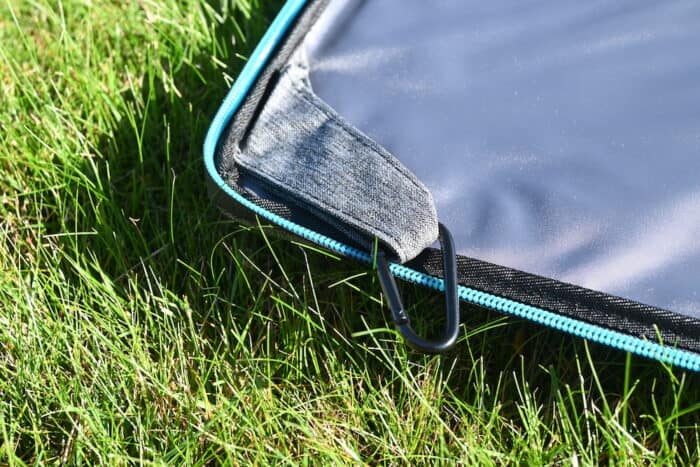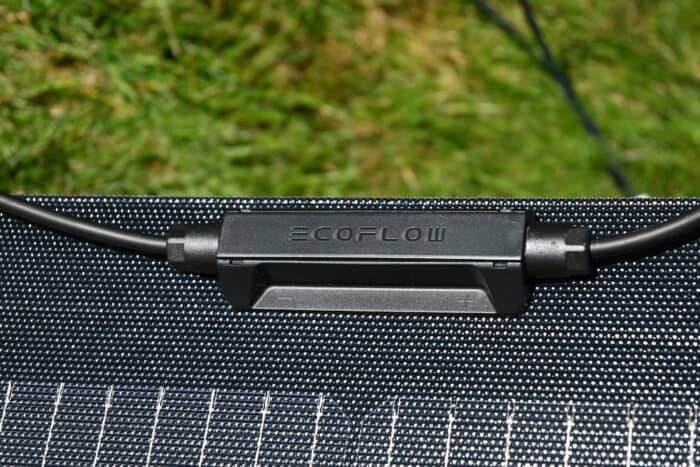Disclaimer: This product was sent to us for free, in exchange for a review. All opinions expressed in this post are based on our personal views and experiences.
How Good Is EcoFlow’s Largest Solar Panel?
Portable solar panels come in a lot of different sizes, and I think EcoFlow is the company that covers the most needs with its lineup.
EcoFlow makes panels that are 60W, 100W, 110W, 160W, 220W, and now 400W.
The one that raises eyebrows (at least it raised mine) is the 400W panel, so I reached out to EcoFlow and asked if I could do a review of it.
How portable does it seem, and how does it perform with the new Delta 2? That’s what I am going to answer in this review.
As always, leave a comment if you have questions.
EcoFlow 400W – Features And Specifications
Output
The 400W panel is rated for 11A at 48V, so it’s a high-voltage panel.
It uses monocrystalline panels which are more efficient than polycrystalline and has an energy conversion rate of 22-23%.

The panel uses MC4 connectors, found on the front of the panels.
Design
It’s not a single 400W panel, but four 100W panels wired together.
The panels fold together to become more portable and fit in the included carrying case.
The very thin panels are protected by an ETFE film to prevent scratches, and with an IP68 rating they can handle being fully submerged in water down to at least 1 meter for up to 72 hours.

There is not a built-in stand, but the carrying case has straps and with the included carabiners, the case becomes a stand.
The carrying case has a reinforced bottom to be more durable when moving and storing the panels.

I also found that it protects the case in certain situations when it’s being used as a stand.
Size And Weight
When folded, the panel measures 41.7 by 24.4 by 0.98 inches.
When unfolded, it measures 41.7 by 93.1 by 0.98 inches.
In the carrying case, the total weight is 41.9 pounds (19 kg).
In The Box
Besides the panels and the carrying case, an MC4 to XT60 adapter is included. This adapter is required to charge EcoFlow power stations with this panel.
Review
What I Like
High Efficiency And Performance
As you’ll see in the test results later on in the article, the panel performs great.
Paired with an EcoFlow power station which has an MPPT solar charge controller, it’s efficient and charges my Delta 2 in less than four hours of sunshine.

MC4 Connectors
I wish all solar panel manufacturers would use MC4 connectors instead of proprietary connectors.
With MC4 connectors, you get a lot of options with connecting the panel to not only power stations but also charge controllers to charge 12V batteries.
You also get the possibility to easily connect several panels together in parallel or series.
It’s a question about compatibility and EcoFlow gives the buyer a choice, which I like and have to point out since it’s not all too common in this market.
Shoulder Strap & Handle
There is not only a handle, but a full-on shoulder strap.

And it’s very useful, since it’s a heavy panel.
Lightweight For The Output
It is a heavy panel and product, but it’s not heavy for what it is. What you get for a little over 10 pounds per 100W is a very waterproof, durable, and efficient panel.
Waterproof
There are not a lot of portable panels like this that are waterproof, and the IP68 rating is actually a huge selling point.

What I Don’t Like
The Stand
I get the idea behind the stand, but it’s not very easy to set up, and it looks sloppy.
It’s great that there is a way to stand up the panel, but it’s so cumbersome to use that during my tests I ended up using it in other ways than intended.

It’s better than nothing, but not much more than that.
As I get more experience with it, I will probably be less frustrated by it though.
No USB Ports Or Charge Controller
A panel with an IP68 rating can’t have a bunch of open ports, and I understand that. But it would’ve been great if EcoFlow included a small charge controller that the panel connects to.
The charge controller could’ve had USB ports, and a way to connect a 12V/24V battery.
For this price, I think EcoFlow should’ve included more accessories to make the panel useable in more situations.
Test Results
I tested the panel around noon in Sweden, in September.
When connected to the Delta 2 which has an MPPT solar charge controller, the screen was showing an average of 350W input. This is when the panel was on the stand, angled towards the sun.

Read my full review of the Delta 2 here.
Considering the circumstances, this is a great number.
With the panel lying flat on the grass, it was producing 220W. Which tells us that angling the panel was definitely necessary in the fall sun.
Is It Compatible With My Power Station?
Thanks to the MC4 connectors, it’s easy to connect the panel to solar charge controllers and other power stations with the right adapter.
Because of the high open circuit voltage, it will not be compatible with most portable power stations on the market, at least not the ones smaller than 500Wh.
The manual of your power station should state what the input port/charge controller can handle, and this will answer whether or not it’s compatible.
If you’re not sure, leave a comment and telling me which power station you have and I’ll do my best to help you figure it out.
Is the EcoFlow 400W A Waterproof Solar Panel?
Yes, with an IP68 rating, I have to call it a waterproof panel.
It can be submerged in water down to a meter (around 3 ft), so rain- and snowstorms should not cause any problems.
How Long Does It Take To Charge The Delta 2 With The 400W Solar Panel?
In my tests, it took around 3.5 hours to charge the Delta 2 from 0 to 100% with the 400W panel. I started charging it around 10 am, and it was done charging before 2 pm.
This test was done in late September in Sweden, in better conditions it could be slightly faster, and possibly slower in worse conditions.
Please leave a comment down below if you have any questions.



Hi Jesse, What solar panels do you recommend with my UGreen 1200 W poweroam? it comes with the xt60 connectors and I got a xt60 adapter to my MC4s for my Renolgy 200 W suitcase. just wanted faster solar charging than I have.
Hi,
According to UGreen, these are the limitations of the solar charge controller: A 11-28V solar charge with XT-60 connector is needed. The current input cannot exceed 12A.
In good conditions, your 200W suitcase produces almost 11A. You could add another panel but the amperage will still be limited to 12A, meaning it won’t increase the charging speeds very much.
I’m not sure why they advertise a 400W solar input limit, since 28V at 12A is 336W. Based on that, there is not much you can do but try to find a panel with a working voltage higher than the 18V your Renogy suitcase outputs.
The EcoFlow 400W solar panel is not compatible since it puts out more than 28V.
VERY helpful review, Jesse, thank you!
Question: I have limited space within which to open up any solar panel(s) I use, and I’m concerned about the awkwardness of the 400W ‘stand’ as you describe it.
Might (2) 220W panels be a ‘better buy’?
[Will appreciate your very prompt answer 🙂 Want to make my purchases asap. TY again!
Hi,
If you mean the EcoFlow 220W, I think they use the same type of stand. I’d say it depends on how much you’re going to be moving the panel(s).
If you’re going to be adjusting them daily then yes I would probably go for the 220W panels just because they’re lighter and easier to deal with, but they’re going to take up more space. Pluses and minuses with both options for sure.